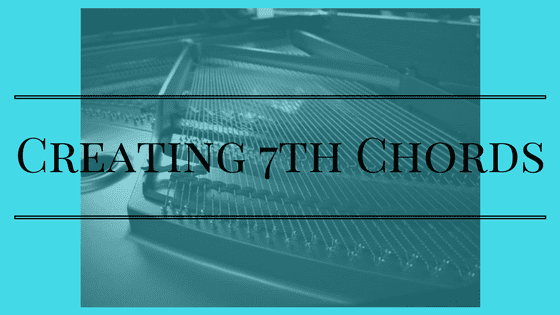An Easy, Beginner's Guide to Creating Seventh Chords And Piano Chords

Piano chords need not be difficult to create! There are several ways that you can form seventh chords at the piano:
1. Number the scale and choose the appropriate scale degrees
2. Use intervals to “stack” notes
3. Use your ear to “hunt and peck” at the notes
Let’s work backwards.
#3 Use your ear to “hunt and peck” at the notes to create seventh chords
This is not a very accurate way of forming seventh chords. However, it will
produce some interesting sounds! I DO like the idea of taking some
time at the piano to “free play”. Simply try creating new chords by
spreading out your fingers and hit three or four notes at a time.
What do you think about the sound you just made?
Sometimes you’ll come up with a sound that you really like. If this
happens, write the notes down! You can create a “black book of
chords” of different piano chords that you like the sound of. When
looking for something to practice, pull out your little black book
of piano chords and practice one of those chords.
#2 Use Intervals to “stack” notes to create seventh chords
You’ll produce accurate seventh chords with this method, but you might not
know the “function” of the notes.
To create a dominant 7th chord, start with the root. Let’s use G as
our root.
Next, go up a Major 3rd higher than G. This note would be B. Now
you have G & B as the first two notes of the G7 chord.
Next, move up a minor 3rd from B and play a D. The notes are now
G-B-D, a Major triad.
Finally, go up another minor 3rd from D and play F.
The complete G7 (G Dominant 7th) chord is G-B-D-F
Using this method requires you to -really- know your intervals.
But, that is a good thing! Here’s a trick, take 2 stacks of note
cards. On one stack (stack A) write one note on each card. So, on
one card, you’d write C. On the next card, write Db. On the next, D
and so on until you have all 12 notes.
On the other set of cards (stack B), write an interval on each
card. So, one card would say Major 3rd. The next card would say
minor 3rd. The next would say Major 2nd and so on. You do not need
to write all of the intervals at this time. You might just want to
start with Major and minor 3rds.
To use the cards, pull one card from stack A and B. So, you might
have Eb — Major 3rd. You need to say what note is a Major 3r
higher than Eb. Do you know? It is G.
This is a great way to learn your intervals.
#1 Number the scale and choose the appropriate scale degrees
I think this is the best all-around method for creating chords.
With this method, you review your scales and also get to know the
function of the notes in each chord. So, let’s go through this
method.
First, you NEED to know your Major scale. The pattern for creating
the Major scale is: W-W-1/2-W-W-W-1/2.
Start on any note. Let’s use F for this example. Now, go up a
whole-step (that’s what the ‘W’ stands for) to G. A few points to
remember. First, when you started on the F, you did not go anywhere
yet. Many students think the first note is the whole-step. In
reality, you need to move between two notes to create the first
whole step. Second, a whole-step is equal to two half-steps. A
half-step is when you move to the very next note higher or lower.
O.K., so we now have F-G as the first two notes of our F Major
scale. Next, move up another whole-step to A. Next, move up a
half-step to Bb (B flat). Now a whole-step to C. Another whole-step
to D. One more whole-step to E. Finally a half-step to F. The
complete scale is:
F-G-A-Bb-C-D-E-F
W-W-1/2-W-W-W-1/2
Now that you have the F Major scale, we number the notes of the
scale.
F=1
G=2
A=3
Bb=4
C=5
D=6
E=7
F=8 or 1
The Dominant 7th pattern is 1-3-5-b7. So, 1=F, 3=A, 5=C and b7=E
flat. The completed F7 chord is F-A-C-Eb.
Using this method, it is easy to see how each note is functioning
in the seventh chord. You know that the 3rd is A and the seventh is Eb. It
also gets you learning your Major scales. More importantly though,
you learn the NOTES of each scale. You will start to recognize the
3rd of a scale or flatted 5th.
Here are the patterns for some other types of chords:
Major 7th: 1-3-5-7
Minor 7th: 1-b3-5-b7
Dominant 7th: 1-3-5-b7
Diminished 7th: 1-b3-b5-bb7 <– that’s double flat! Same note as 6,
so we could write it as: 1-b3-b5-6
Mastering Your Seventh Chords at the Piano
Conclusion
Yikes! That’s a lot of stuff to learn. I know, it has taken me
years to master it. You should now have a better understanding of
how to create these seventh chords in a variety of ways.